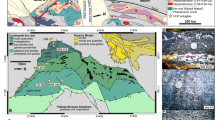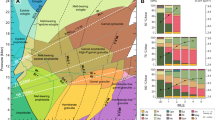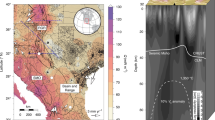Abstract
Continental crust forms and evolves above subduction zones as a result of heat and mass transfer from the mantle below. The nature and extent of this transfer remain debated. Although it has been recognized that arc magmatism at active continental margins can be cyclical at 50- to 1-Myr timescales, such cyclicity has not been recognized in the back-arc. Here we investigate the melting of sedimentary rocks in the continental back-arc of the western Gondwana margin during the Cambrian–Ordovician Famatinian orogeny of Northwest Argentina. We determine the U−Pb ages of zircons that formed during crustal melting and find that they range from 505 to 440 million years ago, concentrated into age groups spaced by 10–15 Myr. This suggests multiple and cyclical melting events in the continental back-arc, which matches the more than 60 Myr duration of the magmatic activity in the arc and demonstrates that thermal and magmatic cyclicity also extends to the continental hinterland. We conclude that back-arc melting reflects a long-lasting, pulsating, cyclical heat transfer from mantle to crust that leads to thorough crustal reworking, transforming sedimentary rocks into crystalline continental crust. Thus, while magma transfer from the mantle promotes crustal growth in convergent margins, cyclical melting promotes crustal maturation of the back-arc.
This is a preview of subscription content, access via your institution
Access options
Access Nature and 54 other Nature Portfolio journals
Get Nature+, our best-value online-access subscription
$29.99 / 30 days
cancel any time
Subscribe to this journal
Receive 12 print issues and online access
$259.00 per year
only $21.58 per issue
Buy this article
- Purchase on Springer Link
- Instant access to full article PDF
Prices may be subject to local taxes which are calculated during checkout



Similar content being viewed by others
Data availability
The authors declare that all data supporting the findings of this study are available within the article and its Supplementary Information.
References
DeCelles, P. G., Ducea, M. N., Kapp, P. & Zandt, G. Cyclicity in Cordilleran orogenic systems. Nat. Geosci. 2, 251–257 (2009).
de Silva, S. L., Riggs, N. R. & Barth, A. P. Quickening the pulse: fractal tempos in continental arc magmatism. Elements 11, 113–118 (2015).
Kirsch, M. et al. Temporal histories of Cordilleran continental arcs: testing models for magmatic episodicity. Am. Mineral. 101, 2133–2154 (2016).
Currie, C. A. & Hyndman, R. D. The thermal structure of subduction zone back arcs. J. Geophys. Res. 111, 1–22 (2006).
Pankhurst, R. J. et al. in The Proto-Andean Margin of Gondwana (eds Pankhurst, R. J. & Rapela, C. W.) 343–367 (Special Publication 142, Geological Society, London, 1998).
Rapela, C. W., Pankhurst, R. J., Saavedra, J. & Galindo, C. Early evolution of the Proto-Andean margin of South America. Geology 26, 707–710 (1998).
Turner, J. C. Estratigrafia de la Sierra de Santa Victoria y adyacencias. Bol. Acad. Nac. Cienc. Cordoba 41, 163–206 (1960).
Ducea, M. N., Otamendi, J. E., Bergantz, G. W., Jianu, D. & Petrescu, L. The origin and petrologic evolution of the Ordovician Famatinian-Puna arc. Geol. Soc. Am. Mem. 212, 125–138 (2015).
Ježek, P., Willner, A. P., Acenolaza, F. G. & Miller, H. The Puncoviscana trough—a large basin of Late Precambrian to Early Cambrian age on the pacific edge of the Brazilian shield. Geol. Rundsch. 74, 573–584 (1985).
Adams, C. J., Miller, H., Toselli, A. J. & Griffin, W. L. The Puncoviscana Formation of northwest Argentina: U-Pb geochronology of detrital zircons and Rb-Sr metamorphic ages and their bearing on its stratigraphic age, sediment provenance and tectonic setting. N. J. Geol. Paläont. Abh. 247, 341–352 (2008).
Bahlburg, H. in The Proto-Andean Margin of Gondwana (eds Pankhurst, R. J. & Rapela, C. W.) 127−142 (Special Publication 142, Geological Society, London, 1998).
Coira, B., Kirschbaum, A., Hongn, F., Pérez, B. & Menegatti, N. Basic magmatism in northeastern Puna, Argentina: chemical composition and tectonic setting in the Ordovician back-arc. J. S. Am. Earth Sci. 28, 374–382 (2009).
Hongn, F. D. et al. The Sierra de Cachi (Salta, NW Argentina): geological evidence about a Famatinian retro-arc at mid crustal levels. J. Iber. Geol. 40, 225–240 (2014).
Büttner, S. H. et al. Ordovician metamorphism and plutonism in the Sierra de Quilmes metamorphic complex: implications for the tectonic setting of the northern Sierras Pampeanas (NW Argentina). Lithos 83, 143–181 (2005).
Sola, A. M., Becchio, R. A. & Pimentel, M. M. Petrogenesis of migmatites and leucogranites from Sierra de Molinos, Salta, Northwest Argentina: a petrologic and geochemical study. Lithos 177, 470–491 (2013).
Bahlburg, H., Berndt, J. & Gerdes, A. The ages and tectonic setting of the Faja Eruptiva de la Puna Oriental, Ordovician, NW Argentina. Lithos 256-257, 41–54 (2016).
Finch, M. A. et al. Tectono-metamorphic evolution of a convergent back-arc: the Famatinian orogen, Sierra de Quilmes, Sierras Pampeanas, NW Argentina. Bull. Geol. Soc. Am. 129, 1602–1621 (2017).
Suzaño, N., Becchio, R., Nieves, A., Sola, A. & Ortiz, A. Mezcla de magmas en el arco magmático Famatiniano del noroeste de Argentina: ejemplo en el complejo intrusivo Diablillos, Puna Austral. Rev. Mex. Cienc. Geol. 32, 433–454 (2015).
Pankhurst, R. J., Rapela, C. W. & Fanning, C. M. Age and origin of coeval TTG, I- and S-type granites in the Famatinian belt of NW Argentina. Trans. R. Soc. Edin. Earth Sci. 91, 151–168 (2000).
Ducea, M. N. et al. Timing constraints on building an intermediate plutonic arc crustal section: U–Pb zircon geochronology of the Sierra Valle Fértil-La Huerta, Famatinian arc, Argentina. Tectonics 29, 1–22 (2010).
Bellos, L. I., Castro, A., Díaz-Alvarado, J. & Toselli, A. Multi-pulse cotectic evolution and in-situ fractionation of calc-alkaline tonalite-granodiorite rocks, Sierra de Velasco batholith, Famatinian belt, Argentina. Gondwana Res. 27, 258–280 (2015).
Lucassen, F. & Becchio, R. Timing of high-grade metamorphism: early Palaeozoic U–Pb formation ages of titanite indicate long-standing high-T conditions at the western margin of Gondwana (Argentina, 26–29°S). J. Metamorph. Geol. 21, 649–662 (2003).
Wolfram, L. C., Weinberg, R., Hasalová, P. & Becchio, R. How melt segregation impacts on granite chemistry: migmatites from the Sierra de Quilmes, NW Argentina. J. Petrol. 58, 2339–2364 (2017).
Young, D. et al. mixtools: tools for analyzing finite mixture models version 3.5.0 (CRAN, 2017); https://cran.r-project.org/web/packages/mixtools/mixtools.pdf
Mezger, K. & Krogstad, E. J. Interpretation of discordant U–Pb zircon ages: an evaluation. J. Metamorph. Geol. 15, 127–140 (1997).
Cherniak, D. J. & Watson, E. B. Pb diffusion in zircon. Chem. Geol. 172, 5–24 (2001).
Corfu, F., Hanchar, J. M., Hoskin, P. W. O. & Kinny, P. Atlas of zircon textures. Rev. Mineral. Geochem. 53, 469–500 (2003).
Harley, S. L., Kelly, N. M. & Möller, A. Zircon behaviour and the thermal histories of mountain chains. Elements 3, 25–30 (2007).
Rubatto, D., Hermann, J., Berger, A. & Engi, M. Protracted fluid-induced melting during Barrovian metamorphism in the Central Alps. Contrib. Mineral. Petrol. 158, 703–722 (2009).
Ducea, M. N., Bergantz, G. W., Crowley, J. L. & Otamendi, J. Ultrafast magmatic buildup and diversification to produce continental crust during subduction. Geology 45, 235–238 (2017).
Yakymchuk, C. & Brown, M. Behaviour of zircon and monazite during crustal melting. J. Geol. Soc. Lond. 171, 465–479 (2014).
Kohn, M. J., Corrie, S. L. & Markley, C. The fall and rise of metamorphic zircon. Am. Mineral. 100, 897–908 (2015).
Sawka, W. N. & Chappell, B. W. The distribution of radioactive heat production in I- and S-type granites and residual source regions: implications to high heat flow areas in the Lachlan Fold Belt, Australia. Aust. J. Earth Sci. 33, 107–118 (1986).
Kemp, A. I. S. & Hawkesworth, C. J. in Treatise on Geochemistry Vol. 3 (ed. Rudnick, R.) 349−410 (Elsevier, Oxford, 2003).
Jamieson, R. A., Beaumont, C., Fullsack, P. & Lee, B. in What Drives Metamorphism and Metamorphic Reactions? (eds Treloar, P. J. & O’Brien, P. J.) 23−51 (Special Publication 138, Geological Society, London, 1998).
Lucassen, F., Lewerenz, S., Franz, G., Viramonte, J. & Mezger, K. Metamorphism, isotopic ages and composition of lower crustal granulite xenoliths from the Cretaceous Salta Rift, Argentina. Contrib. Mineral. Petrol. 134, 325–341 (1999).
Perarnau, M., Gilbert, H., Alvarado, P., Martino, R. & Anderson, M. Crustal structure of the Eastern Sierras Pampeanas of Argentina using high frequency local receiver functions. Tectonophysics 580, 208–217 (2012).
Weinberg, R. F. & Hasalová, P. Water-fluxed melting of the continental crust: a review. Lithos 212-215, 158–188 (2015).
Sola, A. M. et al. Low-P melting of metapelitic rocks and the role of H2O: insights from phase equilibria modelling. J. Metamorph. Geol. 35, 1131–1159 (2017).
Cao, W. et al. Tracking paleodeformation fields in the Mesozoic central Sierra Nevada arc: implications for intra-arc cyclic deformation and arc tempos. Lithosphere 7, 296–320 (2015).
Wiedenbeck, M. et al. Three natural zircon standards for U–Th–Pb, Lu–Hf, trace element and REE analyses. Geostand. Newslett. 19, 1–23 (1995).
Paton, C. et al. Improved laser ablation U-Pb zircon geochronology through robust downhole fractionation correction.Geochem. Geophys. Geosyst. 11, Q0AA06 (2010).
Jackson, S. E., Pearson, N. J., Griffin, W. L. & Belousova, E. A. The application of laser ablation-inductively coupled plasma-mass spectrometry to in situ U–Pb zircon geochronology. Chem. Geol. 211, 47–69 (2004).
Slama, J. et al. Plesovice zircon—a new natural reference material for U–Pb and Hf isotopic microanalysis. Chem. Geol. 249, 1–35 (2008).
Ludwig, K. R. Isoplot/Ex Version 4.0: A Geochronological Toolkit for Microsoft Excel (Berkeley Geochronology Centre, 2008).
Sambridge, M. S. & Compston, W. Mixture modeling of multi-component data sets with application to ion-probe zircon ages. Earth Planet. Sci. Lett. 128, 373–390 (1994).
Acknowledgements
We thank J.-F. Moyen, A. Sola, I. Zibra and A. Kylander-Clark for comments on an early version of the manuscript. This research was supported by the Australian Research Council grant no. DP110102543 (to R.F.W.), FT140101062 (to O.N.) and the Czech Science Foundation grant no. P210-14-25995S (to P.H.). O.N. thanks the Melbourne TIE team for continuing support.
Author information
Authors and Affiliations
Contributions
L.C.W. prepared samples for analysis, performed initial data analysis and took the lead on writing the manuscript. L.C.W., R.F.W. and O.N. contributed to data interpretation and writing the final version of the manuscript. K.H. was responsible for the statistical treatment of the data. P.H. and J.M. conducted laser ablation zircon geochronology. R.B. participated in the fieldwork and developing the original ideas that lead to this paper.
Corresponding author
Ethics declarations
Competing interests
The authors declare no competing interests.
Additional information
Publisher’s note: Springer Nature remains neutral with regard to jurisdictional claims in published maps and institutional affiliations.
Supplementary information
Supplementary Information
Zircon ages, statistical treatment and crustal heat production; Supplementary Tables 1, 2, 3 and 4 and Supplementary Figures 1–9.
Rights and permissions
About this article
Cite this article
Wolfram, L.C., Weinberg, R.F., Nebel, O. et al. A 60-Myr record of continental back-arc differentiation through cyclic melting. Nat. Geosci. 12, 215–219 (2019). https://doi.org/10.1038/s41561-019-0298-6
Received:
Accepted:
Published:
Issue Date:
DOI: https://doi.org/10.1038/s41561-019-0298-6
This article is cited by
-
Late Carboniferous back-arc rifting in Junggar Basin, NW China: implication for the rapid continental growth in accretionary orogens
International Journal of Earth Sciences (2022)
-
Petrogenetic relationships between peraluminous granites and Li- Cs-Ta rich pegmatites in south Issia zone (Central-West of Côte d’Ivoire): Petrography, Mineralogy, Geochemistry and zircon U–Pb Geochronology
Mineralogy and Petrology (2022)



